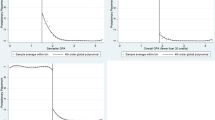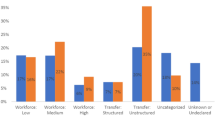Abstract
This research assessed hypotheses regarding several nontraditional styles of postsecondary enrollment: enrolling part-time, delaying postsecondary enrollment for a year or more beyond high-school graduation, and entering nondegree-granting programs. The research was conducted using a sample of 8,203 high-school graduates drawn from the national High School and Beyond data set. Among the findings of the multivariate statistical analyses is evidence that socioeconomically disadvantaged graduates have disproportionately pursued each of the nontraditional enrollment options, even in the context of controls for the respondents' differing academic characteristics. The theoretical, management, and policy implications of these results are discussed.
Similar content being viewed by others
References
Alexander, K. L., and Eckland, B. K. (1977). High school context and college selectivity: Institutional constraints in educational stratification.Social Forces 56:166–188.
Alexander, K. L., and Cook, M. A. (1979). The motivational relevance of educational plans: Questioning the conventional wisdom.Social Psychology Quarterly 42(3):202–213.
Bachman, J. G., and O'Malley, P. M. (1980). The youth in transition series: A study of change and stability in young men. In A. Kerckhoff (ed.),Research in Sociology of Education and Socialization, vol. 1, pp. 127–160. Greenwich, CT: JAI Press.
Bean, J. P., and Metzner, B. S. (1985). A conceptual model of nontraditional undergraduate student attrition.Review of Educational Research 55(4): 485–540.
Begg, C. B., and Gray, R. (1984). Calculation of polychotomous logistic regression parameters using individualized regressions.Biometrika 71:11–18.
Blumenstyk, G. (1989, February 22). More states are providing aid to those who study part time.Chronicle of Higher Education 35(24): A21, A26.
Bowles, S., and Gintis, H. (1976).Schooling in Capitalist America: Educational Reform and the Contradictions of Economic Life. New York: Basic Books.
Brint, S., and Karabel, J. (1989).The Diverted Dream: Community Colleges and the Promise of Educational Opportunity in America, 1900–1985. New York: Oxford.
Cabrera, A. F., Stampen, J. O., and Hansen, W. L. (1990). Exploring the effects of ability to pay on persistence in college.Research in Higher Education 13(3): 303–336.
Carroll, C. D. (1989).College Persistence and Degree Attainment for 1980 High School Graduates: Hazards for Transfers, Stopouts, and Part-Timers. Survey Report CS 89-302 of the National Center for Education Statistics. Washington, DC: U.S. Government Printing Office.
Change Magazine (1986, July/August). Part-timers, Myths and realities, pp. 49–53.
Clark, B. L. (1983).The Higher Education System. Berkeley: University of California Press.
College Board, The (1991).Trends in Student Aid: 1981–1991. Washington, DC: The College Board.
Eckland, B. K., and Henderson, L. B. (1981).College Attainment Four Years After High School. Report prepared for the National Center for Educational Statistics, Office of Educational Research and Improvement, U.S. Department of Education. Research Triangle Park, NC: Research Triangle Institute.
El-Khawas, E. (1990).Campus Trends: 1990. Higher Education Panel Reports, Number 80, July. Washington, DC: American Council on Education.
Fetters, W., Stowe, P., and Owings, J. (1984).Quality of Responses of High School Students to Questionnaire Items. Washington, DC: U.S. Government Printing Office.
Hanushek, E. A., and Jackson, J. A. (1977).Statistical Methods for Social Scientists. Orlando, FL: Academic Press.
Harrell, F. E. (1986). The LOGIST procedure. InSUGI: Supplemental Library Users Guide, Version 5 Edition, prepared by the SAS Institute, pp. 269–293. Cary, NC: SAS Institute.
Harrell, F. E., and Lee, K. L. (1985). A comparison of the discrimination of discriminant analysis and logistic regression under conditions of multivariate normality. In P. K. Sen (ed.),Biostatistics: Statistics in Biomedical, Public Health, and Environmental Sciences, pp. 333–343. New York: North Holland for Elsevier Science Publishers.
Hearn, J. C. (1988). Determinants of postsecondary attendance: Some implications of alternative specifications of enrollment.Educational Evaluation and Policy Analysis 10(2): 172–185.
Hearn, J. C. (1990). Pathways to attendance at the elite colleges. In P. W. Kingston and L. S. Lewis (eds.),The High-Status Track: Studies of Elite Schools and Stratification, pp. 121–145. Albany, NY: SUNY Press.
Hearn, J. C. (1991). Academic and non-academic influences on the college destinations of 1980 high-school graduates.Sociology of Education 63(4):158–171.
Hossler, D., Braxton, J., and Coopersmith, G. (1989). Understanding student college choice. In J. C. Smart (ed.),Higher Education: Handbook of Theory and Research, vol. 5, pp. 231–288. New York: Agathon.
Jackson, G. A. (1978). Financial aid and student enrollment.Journal of Higher Education 49(6):548–574.
Jackson, G. A. (1981). Linear analysis of logistic choices, and vice versa. Paper presented to the Social Statistics Section of the American Statistical Association, Washington, D.C.
Jencks, C., et al. (1979).Who Gets Ahead? New York: Basic Books.
Karabel, J., and Astin, A. W. (1975). Social class, academic ability, and college “quality.”Social Forces 53:381–398.
Kolstad, A. (1981). What college dropin and dropout rates tell us.American Education 17: 31–33.
Lewis, D. R., Hearn, J. C., and Zilbert, E. E. (forthcoming). Efficiency and equity effects of vocationally focused postsecondary education.Sociology of Education.
Manski, C. F., and Wise, D. A. (1983).College Choice in America. Cambridge: Harvard University Press.
Marini, M. M. (1984). The order of events in the transition to adulthood.Sociology of Education 57: 63–84.
National Center for Education Statistics (NCES) (1983).Data Base Documentation for Institutional Characteristics of Colleges and Universities, 1980–81 (IC Survey HEGIS XV). Washington, DC: U.S. Government Printing Office.
National Opinion Research Center (NORC). (1983).Contractor Report, High School and Beyond, 1980 Senior Cohort First Follow-up (1982), Data File User's Manual. Washington, DC: U.S. Government Printing Office.
Paulsen, Michael B. (1990).College Choice: Understanding Student Enrollment Behavior. ASHE-ERIC Higher Education Report No. 6. Washington, DC: The George Washington University, School of Education and Human Development.
Pascarella, E. T., and Terenzini, P. T. (1991).How College Affects Students. San Francisco. Jossey-Bass.
Pavel, M. D., and Reiser, M. (1991). Using national data bases to examine minority student success in higher education. In C. S. Lenth (ed.),Using National Data Bases. New Directions for Institutional Research, No. 69, pp. 5–20. San Francisco: Jossey-Bass.
Peng, S. S., Bailey, J. P., Jr., and Eckland, B. K. (1977). Access to higher education: Results from the National Longitudinal Study of the high school class of 1972.Educational Researcher 6: 3–7.
Pincus, F. L. (1980). The false promises of community colleges: Class conflict and vocational education.Harvard Educational Review 50(3):332–360.
Press, S. J., and Wilson, S. (1978). Choosing between logistic regression and discriminant analysis.Journal of the American Statistical Association 73: 364, 699–705.
Sewell, W. H., and Hauser, R. M. (1980). The Wisconsin longitudinal study of social and psychological factors in aspirations and achievement. In A. Kerckhoff (ed.),Research in Sociology of Education and Socialization, vol. 1, pp. 59–99. Greenwich, CT: JAI Press.
Smart, J. C. (1986). College effects on occupational status attainment.Research in Higher Education 24(1): 73–95.
Solmon, L. (1975). The definition of college quality and its impact on earnings.Explorations in Economic Research 2: 537–587.
Stage, F. K., and Hossler, D. (1989). Differences in family influences on college attendance plans for male and female ninth graders.Research in Higher Education 30(3): 301–315.
St. John, E. P., and Noell, J. (1989). The effects of student financial aid on access to higher education: An analysis of progress with special consideration of minority enrollment.Research in Higher Education 30(6): 563–581.
Thomas, G. E., Alexander, K. L., and Eckland, B. K. (1979). Access to higher education: The importance of race, sex, social class, and academic credentials.School Review 87: 133–156.
Tinto, V. (1980). College origins and patterns of status attainment.Sociology of Work and Occupations 7: 457–486.
Tinto, V. (1987).Leaving College: Rethinking the Causes and Cures of Student Attrition. Chicago: University of Chicago Press.
U.S. Department of Education (1990).The Condition of Education. Washington, DC: U.S. Government Printing Office.
U.S. Department of Education (1992a).Projections of Education Statistics to 2002. Washington, DC: U.S. Government Printing Office.
U.S. Department of Education (1992b).The Way We Are—The Community College as American Thermometer. Washington, DC: U.S. Government Printing Office.
Author information
Authors and Affiliations
Rights and permissions
About this article
Cite this article
Hearn, J.C. Emerging variations in postsecondary attendance patterns: An investigation of part-time, delayed, and nondegree enrollment. Res High Educ 33, 657–687 (1992). https://doi.org/10.1007/BF00992053
Received:
Issue Date:
DOI: https://doi.org/10.1007/BF00992053




